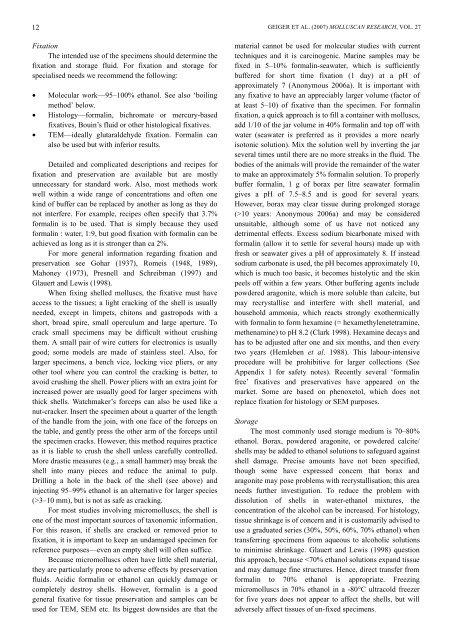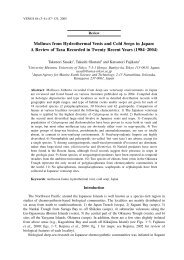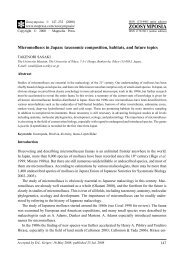Molluscan Research: Techniques for collecting, handling, preparing ...
Molluscan Research: Techniques for collecting, handling, preparing ...
Molluscan Research: Techniques for collecting, handling, preparing ...
You also want an ePaper? Increase the reach of your titles
YUMPU automatically turns print PDFs into web optimized ePapers that Google loves.
12<br />
Fixation<br />
The intended use of the specimens should determine the<br />
fixation and storage fluid. For fixation and storage <strong>for</strong><br />
specialised needs we recommend the following:<br />
• Molecular work—95–100% ethanol. See also ‘boiling<br />
method’ below.<br />
• Histology—<strong>for</strong>malin, bichromate or mercury-based<br />
fixatives, Bouin’s fluid or other histological fixatives.<br />
• TEM—ideally glutaraldehyde fixation. Formalin can<br />
also be used but with inferior results.<br />
Detailed and complicated descriptions and recipes <strong>for</strong><br />
fixation and preservation are available but are mostly<br />
unnecessary <strong>for</strong> standard work. Also, most methods work<br />
well within a wide range of concentrations and often one<br />
kind of buffer can be replaced by another as long as they do<br />
not interfere. For example, recipes often specify that 3.7%<br />
<strong>for</strong>malin is to be used. That is simply because they used<br />
<strong>for</strong>malin : water, 1:9, but good fixation with <strong>for</strong>malin can be<br />
achieved as long as it is stronger than ca 2%.<br />
For more general in<strong>for</strong>mation regarding fixation and<br />
preservation see Gohar (1937), Romeis (1948, 1989),<br />
Mahoney (1973), Presnell and Schreibman (1997) and<br />
Glauert and Lewis (1998).<br />
When fixing shelled molluscs, the fixative must have<br />
access to the tissues; a light cracking of the shell is usually<br />
needed, except in limpets, chitons and gastropods with a<br />
short, broad spire, small operculum and large aperture. To<br />
crack small specimens may be difficult without crushing<br />
them. A small pair of wire cutters <strong>for</strong> electronics is usually<br />
good; some models are made of stainless steel. Also, <strong>for</strong><br />
larger specimens, a bench vice, locking vice pliers, or any<br />
other tool where you can control the cracking is better, to<br />
avoid crushing the shell. Power pliers with an extra joint <strong>for</strong><br />
increased power are usually good <strong>for</strong> larger specimens with<br />
thick shells. Watchmaker’s <strong>for</strong>ceps can also be used like a<br />
nut-cracker. Insert the specimen about a quarter of the length<br />
of the handle from the join, with one face of the <strong>for</strong>ceps on<br />
the table, and gently press the other arm of the <strong>for</strong>ceps until<br />
the specimen cracks. However, this method requires practice<br />
as it is liable to crush the shell unless carefully controlled.<br />
More drastic measures (e.g., a small hammer) may break the<br />
shell into many pieces and reduce the animal to pulp.<br />
Drilling a hole in the back of the shell (see above) and<br />
injecting 95–99% ethanol is an alternative <strong>for</strong> larger species<br />
(>3–10 mm), but is not as safe as cracking.<br />
For most studies involving micromolluscs, the shell is<br />
one of the most important sources of taxonomic in<strong>for</strong>mation.<br />
For this reason, if shells are cracked or removed prior to<br />
fixation, it is important to keep an undamaged specimen <strong>for</strong><br />
reference purposes—even an empty shell will often suffice.<br />
Because micromolluscs often have little shell material,<br />
they are particularly prone to adverse effects by preservation<br />
fluids. Acidic <strong>for</strong>malin or ethanol can quickly damage or<br />
completely destroy shells. However, <strong>for</strong>malin is a good<br />
general fixative <strong>for</strong> tissue preservation and samples can be<br />
used <strong>for</strong> TEM, SEM etc. Its biggest downsides are that the<br />
GEIGER ET AL. (2007) MOLLUSCAN RESEARCH, VOL. 27<br />
material cannot be used <strong>for</strong> molecular studies with current<br />
techniques and it is carcinogenic. Marine samples may be<br />
fixed in 5–10% <strong>for</strong>malin-seawater, which is sufficiently<br />
buffered <strong>for</strong> short time fixation (1 day) at a pH of<br />
approximately 7 (Anonymous 2006a). It is important with<br />
any fixative to have an appreciably larger volume (factor of<br />
at least 5–10) of fixative than the specimen. For <strong>for</strong>malin<br />
fixation, a quick approach is to fill a container with molluscs,<br />
add 1/10 of the jar volume in 40% <strong>for</strong>malin and top off with<br />
water (seawater is preferred as it provides a more nearly<br />
isotonic solution). Mix the solution well by inverting the jar<br />
several times until there are no more streaks in the fluid. The<br />
bodies of the animals will provide the remainder of the water<br />
to make an approximately 5% <strong>for</strong>malin solution. To properly<br />
buffer <strong>for</strong>malin, 1 g of borax per litre seawater <strong>for</strong>malin<br />
gives a pH of 7.5–8.5 and is good <strong>for</strong> several years.<br />
However, borax may clear tissue during prolonged storage<br />
(>10 years: Anonymous 2006a) and may be considered<br />
unsuitable, although some of us have not noticed any<br />
detrimental effects. Excess sodium bicarbonate mixed with<br />
<strong>for</strong>malin (allow it to settle <strong>for</strong> several hours) made up with<br />
fresh or seawater gives a pH of approximately 8. If instead<br />
sodium carbonate is used, the pH becomes approximately 10,<br />
which is much too basic, it becomes histolytic and the skin<br />
peels off within a few years. Other buffering agents include<br />
powdered aragonite, which is more soluble than calcite, but<br />
may recrystallise and interfere with shell material, and<br />
household ammonia, which reacts strongly exothermically<br />
with <strong>for</strong>malin to <strong>for</strong>m hexamine (= hexamethylenetetramine,<br />
methenamine) to pH 8.2 (Clark 1998). Hexamine decays and<br />
has to be adjusted after one and six months, and then every<br />
two years (Hemleben et al. 1988). This labour-intensive<br />
procedure will be prohibitive <strong>for</strong> larger collections (See<br />
Appendix 1 <strong>for</strong> safety notes). Recently several ‘<strong>for</strong>malin<br />
free’ fixatives and preservatives have appeared on the<br />
market. Some are based on phenoxetol, which does not<br />
replace fixation <strong>for</strong> histology or SEM purposes.<br />
Storage<br />
The most commonly used storage medium is 70–80%<br />
ethanol. Borax, powdered aragonite, or powdered calcite/<br />
shells may be added to ethanol solutions to safeguard against<br />
shell damage. Precise amounts have not been specified,<br />
though some have expressed concern that borax and<br />
aragonite may pose problems with recrystallisation; this area<br />
needs further investigation. To reduce the problem with<br />
dissolution of shells in water-ethanol mixtures, the<br />
concentration of the alcohol can be increased. For histology,<br />
tissue shrinkage is of concern and it is customarily advised to<br />
use a graduated series (30%, 50%, 60%, 70% ethanol) when<br />
transferring specimens from aqueous to alcoholic solutions<br />
to minimise shrinkage. Glauert and Lewis (1998) question<br />
this approach, because




